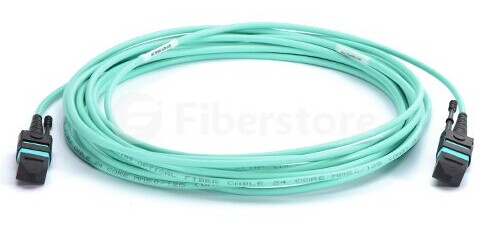In selecting the migration path from 10G to 40/100 G, there are generally two options: the 12-fiber MPO/MTP solution or 24-fiber MPO/MTP solution. A 12-fiber MPO/MTP connector is used for 40 GbE (data rate up to 40Gbps, 4 x 10 Gbps). But among the 12 fibers, only 8 optical fibers are required—4 for Tx and 4 for Rx, and each channel has a transmission rate of 10 Gbps (usually use the 4 left and 4 right optical fibers, and the inner 4 optical fibers are left unused). And for 100 GbE (data rate up to 100 Gbps, 10 x 10 Gbps or 4 x 25 Gbps), there are two solutions. One is to use two 12-fiber MPO/MTP connectors, one transmitting 10 Gbps on 10 fibers and the other receiving 10 Gbps on 10 fibers. The other is to use a 24-fiber MPO/MTP connector. In this situation, misconceptions about 24-fiber connectors and assemblies in MTP/MPO connectivity emerge.
Using 24-fiber cabling throughout an entire channel provides extra flexibility, as users can easily migrate from 10G to 40G or 100G by simply swapping out the connectivity at the end of the channel. Pre-terminated cabling using 24-fiber connectors provides double the density of 12-fiber cabling in the same footprint, reducing the cabling required, allowing for fewer cable pathways, and improving airflow in data centers.
New proposed standards define 100GbE over fewer fibers, as opposed to 20 fibers. This makes 24-fiber connectors superfluous.
The current IEEE 802.3ba 100GBASE-SR10 standard defines 100GbE using 10 lanes of multimode fiber at 10 Gb/s. Progress has indeed been made in delivering 100 GbE over fewer lanes, and the IEEE 802.3bm task force is developing a new standard that would use 4 lanes of multimode fiber at 25 Gb/s per lane. This 4x25 solution would only require 8 fibers (4 transmit, 4 receive) — the same as the current 40GBASE-SR4. That means a 12-fiber MPO/MTP connector can support a single 100G channel. However, a 12-fiber connector for an 8-fiber channel is inefficient, as 4 strands in the 12-fiber connector are not used. Alternatively, by using a 24-fiber MTP connector in the horizontal cabling, it can then be converted into three 8-fiber 100G channels that run over one cable, with all 24 fibers used to support traffic.
Let's look at another example. Say you need to support twelve 100GbE channels using the 4x25 Gb/s standard. With the 12-fiber MPO/MTP connectors, you would need to install 12 connectors, or 144 fibers total, with 33% of the fiber wasted. However, when supporting the same 12 channels with 24-fiber connectors, only 4 cables would be required, using 96 fibers total, at 100% fiber utilization. The 24-fiber MPO/MTP channel solution allows the use of the ratified 100GBASE-SR10 20-fiber technology today, while at the same time maximizing the installed infrastructure investment in the event of 4x25 Gb/s ratification and ultimate implementation. Choosing a 12-fiber connector strategy simply does not accomplish this: it drives down return on investment and subsequently increases the total cost of ownership. This is the exact opposite of the design intent of a data center infrastructure system.
24-fiber connectors don't perform as well as 12-fiber connectors, as higher fiber counts translate into higher insertion loss.
Insertion loss is a critical performance parameter in data center cabling deployments. Lower overall optical loss allows more margin for the network to operate, or in the case for some users, offers the option of more connections for patching locations. The IEEE 802.3ba 40/100GbE standard specifies OM3 fiber to a 100-meter distance with a 1.5 dB total connector loss budget. OM4 fiber for 40/100GbE is specified to a longer distance with a 1.0 dB total connector loss budget. For example, the Push-Pull MPO patch cable from FS.COM is manufactured using laser-optimized, 50/125, OM4 multimode cable, and supports speeds up to 100GbE. As total connector loss increates, the supportable distance at that data rate decreases. However, with the current trend of moving to distributed access/aggregation data center switch strategies such as Top of Rack (ToR), the prevalence of backbone lengths exceeding 100 meters is dramatically decreasing.

Some have mistakenly claimed that higher fiber count leads to higher loss, and one cable vendor pointed to a "typical" loss of 0.5 dB for 24-fiber connectors as evidence. In fact, the industry standard product rating for MPO/MTP connector performance of both 12-fiber and 24-fiber is 0.5 dB maximum. When using proper polishing techniques, 24-fiber MPO/MTP terminations can meet the same performance levels as 12-fiber assemblies. Improved performance can be achieved using low-loss ferrules for both 12-fiber and 24-fiber MPO/MTP connectors rated at 0.35 dB maximum.
24-fiber MTP/MPO solution is a simple and cost effective migration path from 10G to 40/100G Ethernet. It effectively supports all three applications—10, 40 and 100 GbE. Data center managers can easily migrate to higher speeds, with less time and complexity, as 24-fiber solution offers guaranteed performance for 10, 40 and 100G applications, upgrading the cabling infrastructure is as simple as upgrading the fan-out cables or cassettes and fiber patch cords to the equipment. FS.COM provides high quality fiber cables, such as Push-Pull MPO patch cable, Push-Pull LC cable and so on. All these fiber cables can be customized according to your special requirements.










※コメント投稿者のブログIDはブログ作成者のみに通知されます